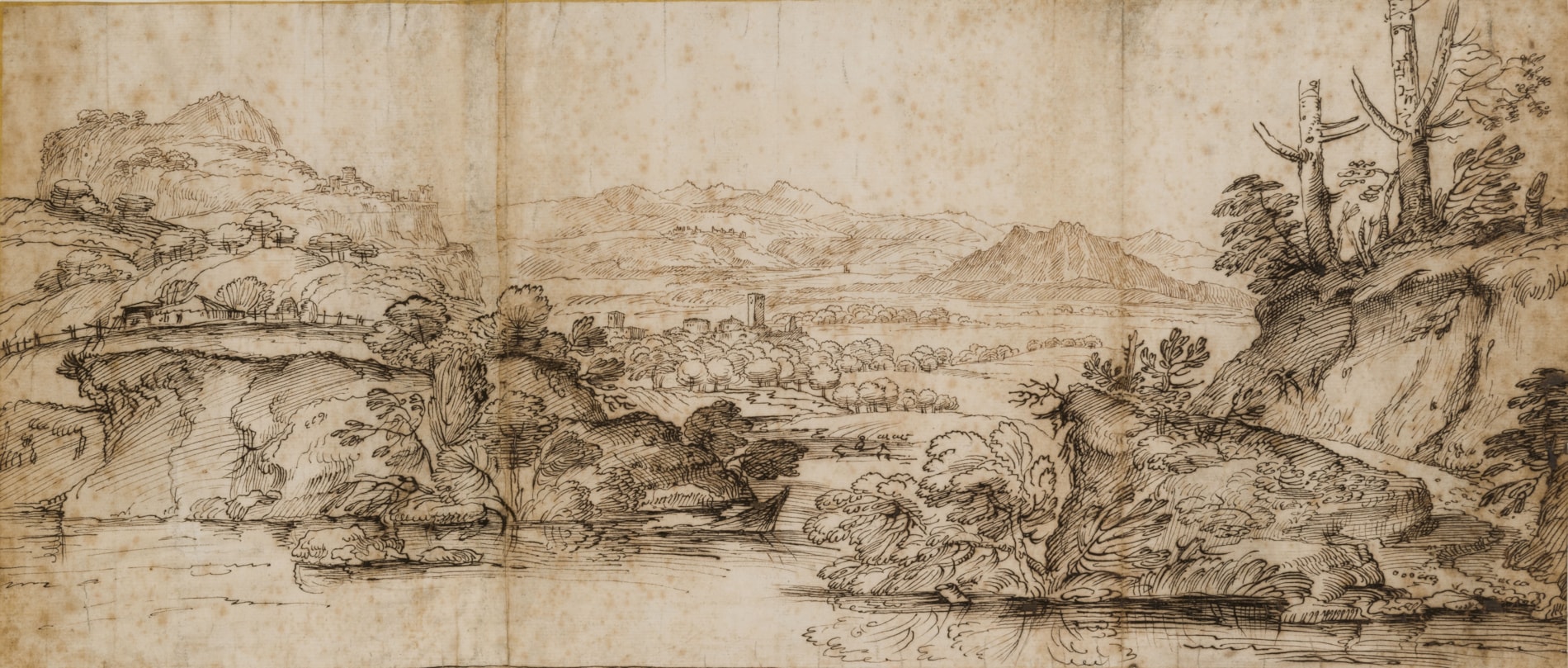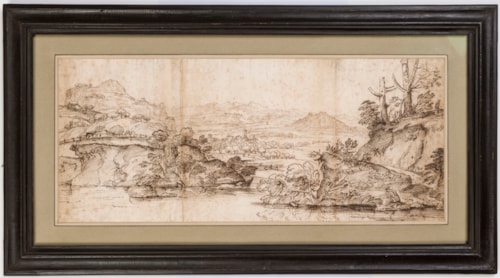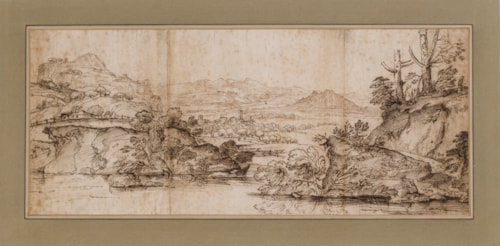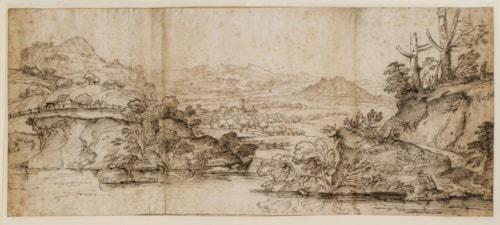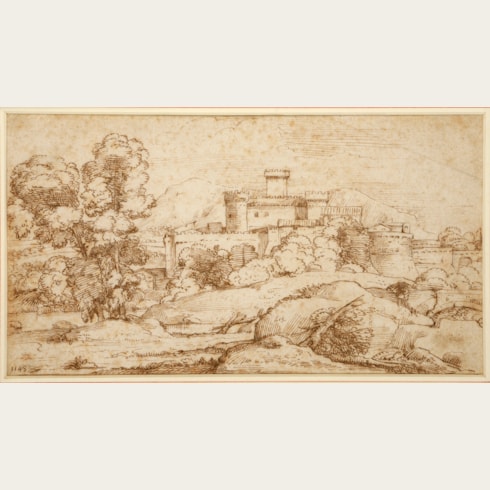Giovanni Francesco GRIMALDI
(Bologna 1606 - Rome 1680)
An Extensive River Landscape
Sold
Pen and brown ink, with traces of a framing line in brown ink at the bottom, on two joined sheets of paper, backed.
258 x 599 mm. (10 1/8 x 23 5/8 in.)
258 x 599 mm. (10 1/8 x 23 5/8 in.)
This exceptionally large and finished landscape by Grimaldi, drawn on two joined sheets of paper, is likely to have been intended as a finished work of art for sale. A comparable frieze-like landscape drawing of slightly smaller dimensions, from the collections of Jonathan Richardson Senior and William Mayor, appeared at auction in London in 1983.
Giovanni Francesco Grimaldi, known as ‘Il Bolognese’, received his artistic training in his native city of Bologna, adopting the local interest in landscape drawing fostered by the Carracci and their Accademia degli Incamminati. By 1627 he was working in Rome, where he profited from his study of the works of the Carracci and their followers there, and in particular their approach to landscape. Grimaldi earned commissions from several noble Roman families, including the Barberini, Borghese, Chigi, Pamphili, Peretti and Santacroce, and was admitted into the Accademia di San Luca in 1635, eventually rising to become principe of the institution in 1666. (In 1643 he was also named to the Congregazione dei Virtuosi al Pantheon, the exclusive Pontifical Academy of Fine Arts and Letters.) As Isabella Lodi-Fè Chapman has noted, ‘The key to Grimaldi’s success was his brilliant ability to assimilate and produce variations of the landscape prototypes that were so popular in Rome. He was therefore often asked to provide the landscape elements of important projects supervised by major artists such as Alessandro Algardi or [Pietro da] Cortona, and also managed entire projects by himself.’
Grimaldi collaborated with Algardi on the decoration of the Villa Doria-Pamphili for Cardinal Camillo Pamphili in 1646. He enjoyed a highly successful career as a painter of fresco decorations, working at the Palazzo Nuñez, the Vatican and the Palazzo Quirinale in Rome, as well as the Villa Falconieri at Frascati. His reputation as a frescante spread as far as France, where in 1648 he was summoned by Cardinal Mazarin to work with Giovanni Francesco Romanelli on the fresco decoration of the Galerie Mazarin, part of a new wing of his Parisian palace commissioned from the architect François Mansart in 1644. Grimaldi served as painter to the Duc d’Orléans and decorated the apartments of Anne of Austria in the Louvre before returning to Italy in 1651. For much of the 1670s Grimaldi worked at the Palazzo Borghese in Rome, supervising the interior decoration of the building. A versatile artist, he was also active as a printmaker, architect, scenographer and a designer of book illustrations.
A prolific draughtsman, Grimaldi is best known for his pure landscape studies in pen and ink. Only a very few of these, however, are signed or dated, and since his style as a draughtsman remained fairly consistent during his career such drawings can be difficult to date with any accuracy. While some of his landscape drawings were used to prepare the decorative murals that the artist painted for Roman palaces, others may well have been intended for sale as works of art in their own right. (A number of landscape drawings that incorporate figures by Algardi are also known.) An album of around 130 landscape drawings and decorative designs by Grimaldi, assembled in Rome by the Spanish painter Vincenzo Vittoria before 1701, is today in the British Museum, while a smaller number of drawings with the same provenance is in the Royal Library at Windsor Castle. Other significant groups of drawings by the artist are in the collections of the Statens Museum for Kunst in Copenhagen, the Teyler Museum in Haarlem, the Louvre in Paris, the Nationalmuseum in Stockholm and the University Library in Warsaw. Grimaldi also produced more than sixty landscape etchings, which, like his drawings, reveal the influence of the Carraccesque tradition in which he was trained and, by extension, the work of Domenichino in Rome.
Grimaldi collaborated with Algardi on the decoration of the Villa Doria-Pamphili for Cardinal Camillo Pamphili in 1646. He enjoyed a highly successful career as a painter of fresco decorations, working at the Palazzo Nuñez, the Vatican and the Palazzo Quirinale in Rome, as well as the Villa Falconieri at Frascati. His reputation as a frescante spread as far as France, where in 1648 he was summoned by Cardinal Mazarin to work with Giovanni Francesco Romanelli on the fresco decoration of the Galerie Mazarin, part of a new wing of his Parisian palace commissioned from the architect François Mansart in 1644. Grimaldi served as painter to the Duc d’Orléans and decorated the apartments of Anne of Austria in the Louvre before returning to Italy in 1651. For much of the 1670s Grimaldi worked at the Palazzo Borghese in Rome, supervising the interior decoration of the building. A versatile artist, he was also active as a printmaker, architect, scenographer and a designer of book illustrations.
A prolific draughtsman, Grimaldi is best known for his pure landscape studies in pen and ink. Only a very few of these, however, are signed or dated, and since his style as a draughtsman remained fairly consistent during his career such drawings can be difficult to date with any accuracy. While some of his landscape drawings were used to prepare the decorative murals that the artist painted for Roman palaces, others may well have been intended for sale as works of art in their own right. (A number of landscape drawings that incorporate figures by Algardi are also known.) An album of around 130 landscape drawings and decorative designs by Grimaldi, assembled in Rome by the Spanish painter Vincenzo Vittoria before 1701, is today in the British Museum, while a smaller number of drawings with the same provenance is in the Royal Library at Windsor Castle. Other significant groups of drawings by the artist are in the collections of the Statens Museum for Kunst in Copenhagen, the Teyler Museum in Haarlem, the Louvre in Paris, the Nationalmuseum in Stockholm and the University Library in Warsaw. Grimaldi also produced more than sixty landscape etchings, which, like his drawings, reveal the influence of the Carraccesque tradition in which he was trained and, by extension, the work of Domenichino in Rome.
Provenance
Anonymous sale, Paris, Artcurial, 9 June 2021, lot 32
Private collection, London.
Private collection, London.

